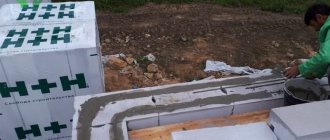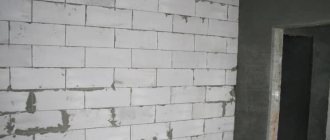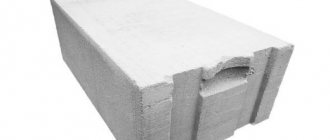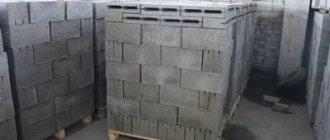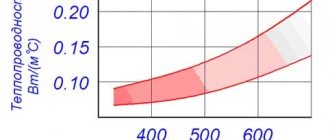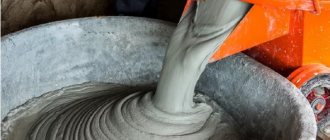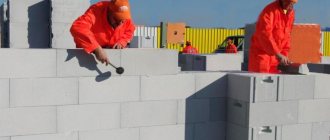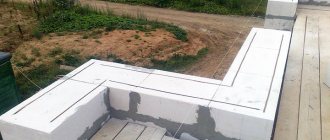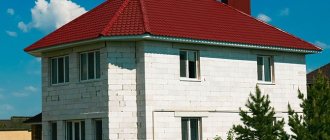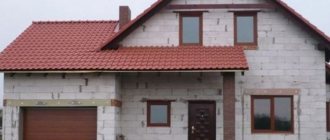Aerated concrete is one of the most common materials for construction. It is lightweight and can significantly reduce the load on the foundation. When planning to build something, you will need to calculate the number of gas blocks that will be needed for construction. To do this, you need to know how many blocks are contained in 1 cubic meter, and what dimensions they have. The most common block size is 600x300x200 mm. Due to the larger area of the blocks than bricks, using aerated concrete you can build everything much faster.
How many Arbolite blocks are on a pallet?
The concept of specific gravity. Weight of an arbolite cube and the weight of an arbolite block
| Block type | Block volume , m3 | Quantity on pallet , pcs. |
| Standard 500 x 300 x 250 mm | 0,0375 | 50* |
| Standard 500 x 300 x 200 mm | 0,03 | 48* |
| Foam arbolite 500 x 300 x 250 mm | 0,0375 | 50* |
| Partition 500 x 300 x 142 mm | 0,0213 | 48 |
How many gas blocks are in one cubic meter?
To best understand how to count materials for a project, let's look at an example right away. So, let’s say we have a box 6 by 4 m, 3 m high. We plan to install in it 3 window openings 1.5 by 1.5 m and a doorway 2 by 1 m. What are our actions:
- First, we calculate the volume of the wall made of aerated blocks. (6+4)*3=60 cubic meters m. At this stage, windows and doors are not taken into account.
- Now we calculate the volume of openings. 1.5*1.5*3+2=8.75.
- The final volume is 60-8.75=51.25 cubic meters. m.
Now it is clear how the number of gas blocks is calculated. It is necessary to find out how many blocks are in 1 m3. To do this, we convert 1 m3 to cm. It turns out 1,000,000 cm3 (100x100x100). If we take the value of the most popular block size 600x300x200 mm, we get a volume equal to 36,000 cm3. Now, in order to find out the number of gas blocks in 1 m3, we need 1,000,000/36,000 = 28 pieces.
To find out the number of blocks that will be needed for the entire structure, you need to multiply 28 by 51. The result is 1428 (1430) blocks.
The table below shows values for blocks of different sizes and densities.
| Dimensions of aerated concrete block (ACB), mm | Density, kg/m³ | Weight of one block, kg | Volume of one block, m³ | Number of blocks in a pallet, pcs. | Volume of blocks in a pallet, m³ | Weight of blocks in a pallet, kg |
| 600×300×200 | 500 | 18 | 0,036 | 32 | 1,152 | 576 |
| 600×300×200 | 600 | 22 | 692 | |||
| 600×300×200 | 700 | 25 | 807 | |||
| 600×300×250 | 500 | 22,5 | 0,045 | 24 | 1,08 | 540 |
| 600×300×250 | 600 | 27 | 648 | |||
| 600×300×250 | 700 | 32 | 762 |
How many gas blocks can be transported at a time?
When transporting material, its most important parameter is weight. Depending on the weight, you need to select the transport on which you will transport aerated concrete. Loading and unloading of blocks should be done using a manipulator, without opening the packaging and without violating the integrity of the pallets.
The table below shows the weight parameters for the most popular type of blocks.
| Block sizes | Weight of one block, kg | Weight of pallet with blocks, kg |
| 600×300×200 | 18 | 576 |
| 600×300×200 | 22 | 692 |
| 600×300×200 | 25 | 807 |
| 600×300×250 | 22,5 | 540 |
| 600×300×250 | 27 | 648 |
| 600×300×250 | 32 | 762 |
The different weights of the blocks are due to the different densities of aerated concrete. The higher the density of the block, the fewer pores containing air it contains, and, accordingly, the higher its weight.
If you hire a regular KAMAZ dump truck to transport the material. Depending on the size and weight of the blocks, you can transport approximately 8 - 15 pallets of aerated concrete at a time.
Weight
The weight of an aerated block, just like its size, can be very different and depends not only on the dimensions, but also on the density. The higher the density of concrete, the more it weighs.
Types of aerated concrete by weight and density:
The lightest - they have many pores, the density is minimal, the material is usually used as insulation; it is not suitable for laying walls due to its low strength. The mass of such blocks is 200-500 kilograms per cubic meter. Heavy gas blocks are the most common option. A cubic meter weighs up to 500-900 kilograms. These blocks are ideal for constructing walls of low-rise buildings. Extra-heavy gas blocks - 900-1200 kilograms per cubic meter. Such blocks are used in high-rise construction; they are considered the most durable and dense, but also the heaviest.
Currently reading: Foam concrete blocks
In order not to make a mistake when choosing a material, just look at its brand - it corresponds to the density, the number of kilograms per cubic meter. Thus, the brand of aerated block D400 indicates that the density of the material is 400 kg/m3, D600 – 600 kg/m3, etc.
QUALITATIVE ADVANTAGES OF AEROBEL BLOCKS FROM AEROBEL
You can place an order for blocks or get the necessary information by calling us at: 8(985)265-15-91 / 8(926)917-50-62 /
Adhesive for gas silicate blocks "AeroBel"
The adhesive is used for masonry work in the construction of external, internal walls and partitions. The glue is waterproof, and the prepared solution is also used to level surfaces and fill plaster defects. For work in winter conditions at temperatures down to minus 15ºС, glue with an anti-frost additive is produced, which is designated “WINTER” on the packaging.
Preparation of glue
To prepare the solution, pour the contents of the bag, with constant stirring, into a container with clean water at the rate of 1 kg of dry mixture per 0.2 liters of clean cold water (for 1 25 kg bag - 5.0 liters of water) and mix until a homogeneous mass is formed. Mixing is done mechanized (professional mixer or electric drill with an attachment) or manually. The solution must be kept for 5 minutes, then mixed again. After this, the solution is ready for use.
The solution can be used within 3 hours from the moment of mixing with water. When the viscosity of the solution in the container increases (within the pot life time), it is necessary to mix it thoroughly without adding water.
To prepare the solution, use only clean containers, tools and water.
Block laying
Apply the prepared solution to a clean, dry surface of the blocks using a notched trowel with a tooth size of 6 mm. Then, within 10 minutes, while the mixture retains its adhesive properties, the solution should be laid and the blocks adjusted. The thickness of the mortar between the blocks after laying should be 2-3 mm.
Material consumption
1.4 kg of dry mixture per 1 dm3 of solution.
Shelf life
The shelf life in a dry place in undamaged original packaging is up to 12 months from the date of manufacture.
Advantages of masonry with glue
Firstly, using glue is cheaper than using cement-sand mortar. Glue consumption per 1 m3 of masonry is eight times less.
Secondly, the use of fine-grained glue eliminates the formation of so-called “cold bridges” - layers of material with high thermal conductivity, leading to a decrease in the uniformity of the masonry and an increase in heat loss.
Thirdly, a thick layer of mortar can make the masonry uneven, and the glue only emphasizes the evenness of the AEROBEL blocks.
Aerated concrete masonry with a thin-layer adhesive mortar is stronger than masonry with cement-sand mortar with thick seams. Both the compressive strength and flexural strength of such masonry will be higher due to the surface adhesion between the cellular concrete and the glue.
place an order for adhesive for gas silicate or get the necessary information by calling us at: 8(985)265-15-91 / 8(926)917-50-62 /
CarriageDesigned for applying mortar to the horizontal surface of blocks during laying (the width of the working part of the carriage is 200, 250, 300,375,400). The carriages allow you to dose the glue in a uniform layer, ensuring the same thickness of the seam throughout the entire masonry. We recommend using carriages of appropriate sizes for all standard sizes of AEROBEL blocks. | |
LadleAn effective tool for applying glue to the vertical surfaces of blocks for masonry and for the construction of walls of complex configurations (the width of the working part of the bucket is 100, 150, 200, 250, 300, 375, 400). | |
MixerFor mixing adhesive compositions. | |
LevelFor monitoring vertical and horizontal masonry surfaces. | |
Notched spatulaFor applying glue to the surface of blocks. | |
Rubber malletFor leveling the horizontal and vertical planes of the block during laying. | |
HacksawFor sawing blocks, it allows you to produce additional blocks directly on the construction site. | |
Wall chaserFor quick production of grooves when installing pipes and electrical wiring in walls. | |
SquareTo ensure the accuracy of cutting blocks. | |
PlaneTo eliminate differences between block connections. | |
Options
The sizes of gas blocks can be very different, as well as the shape and design. Blocks for laying walls are usually made in the shape of a large parallelepiped. An example of a standard size is 60 centimeters in length, 30 centimeters in height and 20 in width. Several other standard sizes are also common, but there are also blocks for internal walls (they are smaller), additional elements, and products of special design.
There are two types of gas blocks
For most tasks at construction sites, it is enough to have two types of aerated concrete blocks - conventional rectangular and U-shaped, which are relevant for performing different parts of the structure. In addition, the shape of the blocks can be different.
What types of gas blocks are there by type and shape:
- Rectangular blocks - used for the construction of internal partitions and external load-bearing walls. Reinforced aerated concrete beams - for creating ceilings. The floors are assembled from T-shaped beams measuring 60x25x20 centimeters, window/door openings are made from U-shaped blocks, which can significantly speed up the installation process and reduce labor costs. Arc-shaped gas blocks, lintels - are used to facilitate the construction process (certain parts of the structure are made from them).
When choosing aerated concrete blocks, it is important to know the production technology of the material. There are two options in total and in general they are similar, but differ in key parameters. The mixture is prepared for pouring into a mold according to the same recipe, but in the case of autoclaved aerated concrete, the solution is poured into one large mold and sent to an autoclave, where it is subjected to high pressure and temperature.
Non-autoclaved aerated concrete is poured into molds and then dried under natural conditions. In this case, the material turns out to be less durable, and there may be chips and peeling on it.
For construction, it is better to choose autoclaved aerated concrete, which may cost more, but demonstrates much higher performance characteristics.
Standard product sizes
The standard block sizes were indicated above (600x300x200 millimeters), and other standard sizes can also be included.
What sizes are usually used:
Length – from 60 to 62.5 centimeters. Height – from 20 to 25 centimeters. Width – from 8.5 to 40 centimeters.
Below are the possible options:
U-shaped products are produced with the following parameters
Standard products of this form usually have the following dimensions: 25 centimeters in height, 50-60 centimeters in length and 20-40 centimeters in width. Before purchasing building materials, you must carefully measure everything and calculate how many gas blocks are needed and where. Calculations are carried out according to the same scheme as in the case of conventional gas blocks.
Calculations
To perform calculations and find the required volume of aerated concrete, you first need to correctly calculate the structure. They calculate the height and width of the walls, the dimensions of the entire building, and internal partitions. Then the length of the walls is multiplied by the height and the total area in square meters is obtained. Next, the thickness of the walls is determined and the resulting indicator is multiplied by the thickness in meters (0.2, 0.3, 0.4, which is equal to 20, 30, 40 centimeters, respectively) and the required volume of the gas block in cubic meters is obtained.
After this, you need to find how much cubic volume is per block - multiply all its sides and divide by the resulting figure one. Then it is enough to multiply the number of cubic meters by the number of blocks per cubic meter and get the desired value - the number of pieces of aerated concrete blocks.
Usually, the examples do not take into account the thickness of the seam, so you don’t have to add the classic 7-10% to the resulting figure. The seams can be thin when using special glue or medium thickness if the masonry is carried out using cement-sand mortar.
Despite the fact that a package of glue costs more than an identical volume of masonry mixture, in the end it turns out to save both due to the thickness of the seams and on heating, since the glue does not create cold bridges.
Knowing how many aerated concrete blocks in 1m3 is desirable for everyone who starts construction. Even if all these volumes and figures can be calculated in production or in a store, there will be no doubt about the correctness and correctness of the calculations performed independently.
